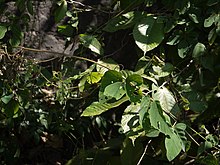Mucuna monosperma, commonly known as negro beans in India, or deer-eye beans, donkey-eye beans, or ox-eye beans, is a large woody climber from the family Fabaceae.[2] The plant has three layers; a brown pod covered in small hairs, curved petals usually colored purple and black round-shaped beans. Small hairs on the pod can irritate the skin.The petals of the Muncuna monnosperma flower opens at night and closes in the morning.[3] It is found in India, including the eastern Himalayas, the northeastern states, and the Andaman and Nicobar Islands, Sri Lanka, Bangladesh, Myanmar, and Thailand.[1] Its natural habitat is evergreen forests, and it commonly grows near swamps or along streams.[2]
| Mucuna monosperma | |
|---|---|

| |
| Scientific classification | |
| Kingdom: | Plantae |
| Clade: | Tracheophytes |
| Clade: | Angiosperms |
| Clade: | Eudicots |
| Clade: | Rosids |
| Order: | Fabales |
| Family: | Fabaceae |
| Subfamily: | Faboideae |
| Genus: | Mucuna |
| Species: | M. monosperma
|
| Binomial name | |
| Mucuna monosperma | |
It is discovered that M. monosperma contains L-DOPA, which is a chemical compound commonly used against Parkinson's disease. The beans of the plant contains 5.48% L-DOPA, and the content increases 6.58% when beans are soaked in water.[4] Another research showed that M. monosperma can accelerate melanin production that can be beneficial in cosmetics, agriculture and medicine.[5]
Other than its possible medical uses, M. monosperma has already been consumed as food in areas where it is endemic to. According to Dr. Sturtevants, it is a well-loved fruit among Brahmins.[6]
References edit
- ^ a b "Mucuna monosperma Roxb. ex Wight". Plants of the World online. Royal Botanic Garden Kew Science. Retrieved 31 March 2018.
- ^ a b Sardesai, Milind; Govekar, Ravikiran; Yadav, SR (2013). Field Guide to the Plants of Sahyadri and Konkan. Pune: Forest Department, Government of Maharashtra. p. 150.
- ^ "Mucuna monosperma - Negro Bean". www.flowersofindia.net. Retrieved 2022-01-28.
- ^ Inamdar, Shrirang; Joshi, Swati; Jadhav, Jyoti; Bapat, Vishwas (2012). "Innovative Use of Intact Seeds of Mucuna monosperma". Natural Products and Bioprospecting.
- ^ Inamdar, Shrirang; Joshi, Swati; Bapat, Vishwas; Jadhav, Jyoti (2013-12-03). "Innovative use of Mucuna monosperma (Wight) callus cultures for continuous production of melanin by using statistically optimized biotransformation medium". Journal of Biotechnology.
- ^ Sturtevant, Edward Lewis (1972). Sturtevant's Edible Plants of the World. Dover Publications.
External links edit
Data related to Mucuna monosperma at Wikispecies